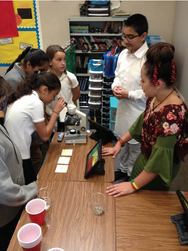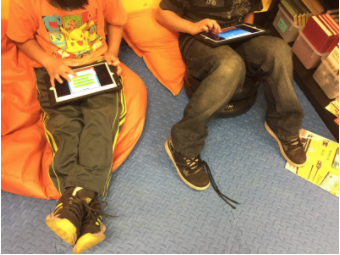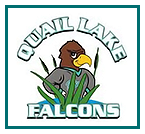|
Our second to the last story comes from Quail Lake Charter School. 7th Grade teacher, Rachel Groft shares her experiences with how choices and saying "YES!" leads to deeper conceptual knowledge and student innovation. Super inspiring and a great example of easy ways to embed UDL into lessons and experiences. Thanks Rachel! Enjoy everyone! Learning to Say "Yes!"By Rachel Groft, 7th Grade ELA & SS Teacher  Back when my oldest son was little, I remember hunting around for preschools, looking for the perfect school to foster his creativity and grow his little mind. In one class, I saw some simply adorable art projects hanging on the wall. You know the kind… the teacher provides a template, gives each student a few pre-cut shapes, maybe some popsicle sticks, and some paint, and has each student re-create the adorableness. Whola! A bunch of fun. And then there was an entirely different classroom. No piece of artwork looked the same. I remember watching as the little one with chubby cheeks and long ringlets asked her teacher for a piece of celery, wanting a snack perhaps? The teacher hunted through her fridge but could not find any celery. “I’m sorry, but would a carrot or piece of broccoli work?” The little one thought for a moment, and grinned. Off she went with such joy and eagerness... to paint her snowman. The broccoli made for a perfect paint brush when texturing snow, and the carrot, well, it did a fantastic job of painting curly hair on her one-of-a-kind snowman! When was the last time you said “Yes!” to a student asking to do something a “different” way? An out-of-the-box way? A way you have never seen done before? A way that might, if you’re being honest, make you a little uncomfortable, take a little more time, or involve a supply you don’t have? My encouragement to you today is to push yourself toward “Yes!” If saying yes still allows a student to meet the assignment goal, go for it! It promotes an excitement and love of learning like no other word can. With most of my major class assignments, my rubrics offer two, three, or maybe four options for assignment completion... but they always offer, “If you have a different great idea, ask me. I bet I’ll say yes!” At the start of the school year, and especially with students who do not like taking risks, most of my students will utilize a tool or resource that I suggest or that is specified on a rubric… a specific website, a certain app, a previously used graphic organizer. But as the year goes on, and I encourage, encourage, encourage students to come up with their own creative ideas, a couple students will slowly start to emerge from their turtle shells and ask to do extremely innovative and exciting things! And WOW how learning can explode! Other students inquisitively watch, and bravely begin to innovate and try their own ideas. A mock interview could turn into an actual interview with an immigrant from Egypt or a resident of Ethiopia. A three-flap foldable could turn into an interactive game on an app. A paper design for a water filtration system could turn into a 3D-printed filter. An individual project on a famous historical figure could turn into a group project on a set of historical figures and how their overlapping contributions affect our culture today. A 3-dimensional map could be created using anything from cotton swabs to legos to rotating trading ships built from clay and cardboard. The sky is the limit! Try saying “Yes!” in your classroom, as uncomfortable as it may be. Keep trying, even if it doesn’t go well, and you will certainly see some amazing things!
1 Comment
Hell0! This week we are excited to showcase the efforts of a third grade teacher and his team out in Sequoia Elementary. Tyler Yost, one of our amazing new teachers, writes about his initial experiences incorporating Universal Design for Learning as a design lens for his instruction. He dove in head first with us last year during connecting in with our 3rd grade pilot team mid year. Hope you enjoy his story! Only 2 more stories left! I had the great opportunity of joining a third grade team at Sequoia Elementary who were just starting their journey of Universal Design for Learning. As a brand new and young teacher, there are many challenges you face without having classroom experience. For most new teachers, like myself, the challenge is always classroom management. How do I have all of these different minds, personalities, needs, and more from each of my students, and make it all work? That is why I feel so fortunate to have landed in such a great position of a UDL pilot team. New teachers are just trying to figure out how this “teaching” thing works. UDL gave me direction and the opportunity to take risks in my classroom. Originally, I thought UDL is never going to work. If I give up control, have a flexible moving classroom, give kids options, there is going to be CHAOS. Which at times, there was. “Organized” chaos as I would like to call it. "Originally, I thought UDL is never going to work. If I give up control, have a flexible moving classroom, give kids options, there is going to be CHAOS." What I started to find through lots of trial and error however, is that empowering students and creating a culture that shows you have a voice, options, and have something to offer, can lead to some really great things. I started used the UDL guidelines more of an assessment of how I am running my classroom. Especially focusing on how are my students engaged? Starting from the beginning, looking at specifically 7.2, and 7.3. In a nutshell why does what they are learning matter to my students? Is it relevant? Also, is my classroom safe and set up in a way they are focused and not distracted? "What I started to find through lots of trial and error however, is that empowering students and creating a culture that shows you have a voice, options, and have something to offer, can lead to some really great things."  It was the little things that ended up making the biggest differences. Being intentional about how my classroom is set up, the supplies and supports they have, and how they interact and move within the classroom. As I have moved into my second year with more experience of UDL, I have seen my classroom management improve, student learning improve, and seen how much a universally designed classroom can change things for students. Happy New Year Everyone! As we share our last few stories from the field, we want to bring your attention to Del Rey Elementary! Gloria Robles and Debbie Neal, two incredible 2nd grade teachers wanted to share how Universal Design for Learning as impacted their instruction. From last year participating in pilots to this year being leaders for UDL on their campus, they are a wealth of knowledge and experience in all things related to the instruction and care for students in the community of Del Rey. Super excited to share their insights! Take a look! We are so excited that we made the decision to pilot UDL. This is our 2nd year but we can say that the first year was a little overwhelming but a wonderful learning experience as we got familiar with UDL and the UDL guidelines. We focused on Engagement, and with the help of Zach, we were able to create a Compare and Contrast lesson. The lesson began with a short Disney movie clip that got the student’s attention. They were very engaged in collaborating with each other on what was the same and different between the two characters. We also used images such as SpongeBob and the Minions for the students to orally practice using the color-coded vocabulary words and sentence frames for them to compare and contrast the two images. At the end, the students had options to share their compare and contrast sentence by writing it, using Chatterpix to record their sentence, or telling the teacher. One realization I discovered through this lesson is that students who could not write a thorough response did understand the concept as measured by their verbal response. They were able to say the sentence with great detail and understanding of the concept. So that showed me that the writing was a barrier for them but with the option to orally share their answer it showed me they could do it and they met the goal! We also worked on the Environmental Problem of Practice, which took place during transition time at the end of the day. What used to be controlled chaos at the end of the day became a smooth flowing learning experience with little teacher direction. We created a powerpoint and check off list with step by step directions and images of what it should look like as they prepared to go home. Before being dismissed, students had to self-reflect on how they did by using a 1-4 scale. Students would share what went well and what they could get better at for the next day. Zach suggested adding a song to signal when it was time to clean up and go home. We were a little skeptical but we tried it and it worked!! Eventually this evolved from it being teacher led to student led. When they heard the music, they knew it was time to transition home and used the checklist as a guide. It was great to see that with a push of a button we were ready to go home in record time. Now in our 2nd year, it’s getting easier to implement UDL and we are seeing things differently. Our UDL lens allows us to prepare a lesson and focus on key UDL questions during lesson design and development. Engagement and representation strategies have been a focus for our lessons while providing options for our students to be able to show their understanding in different ways and using different tools. We have seen such positive results with implementing UDL and knocking down the barriers students may face so they can be successful. Sample Music to listen to as you enjoy an amazing blog post! |
Sanger UnifiedArchives
January 2019
Categories
Podcast Archives
|
Pictures are Worth 1000 Words
|
Sanger unified school district |
Curriculum & Instruction department |








 RSS Feed
RSS Feed